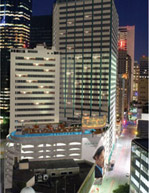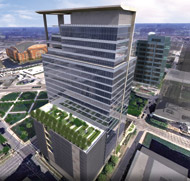| COVER STORY, DECEMBER 2006
MOVING INWARD
The latest urban developments in Texas are giving residents new reasons to consider intown living.
Stephen O’Kane
With a large influx of people coming to the Lone Star State each day, developers are recognizing the need for new urban development projects. Residents are beginning to see the importance of convenience, and urban developments are bringing this to life by creating a sense of place within the larger metropolitan areas. The key to successful urban development is maximizing space to get the most out of the property, and currently, several projects have taken root in Texas to cater to the need.
“Urban development is a lifestyle and not just a trend,” says Milton Anderson, director of design for Merriman Associates/Architects. “The city core has become the place to live, work and play. Merriman is developing residential mixed-use high-rises and historical residential restorations, which attract retailers and restaurants, and creates needs for other services like grocery stores. This in turn spurs growth.”
 |
Merriman Associates/Architects is working with Hamilton properties to construct The Mosaic, an urban redevelopment project located in downtown Dallas.
|
|
One such project is The Mosaic, an urban development of Hamilton Properties in downtown Dallas. Merriman Associates/Architects is currently constructing the project, which will include 440 luxury apartments averaging 1,235 square feet each. The Mosaic, which is considered by some to be the largest residential conversion in downtown Dallas, will redevelop the Fidelity Union and Mayflower buildings. The Fidelity Union Building was constructed in 1952 and spans 21 stories, while the Mayflower Building opened in 1960 and spans 32 stories.
The first floors of The Mosaic will include several retail tenants as well as historic lobbies and will feature amenities that include an upscale restaurant, a full-service fitness center and a neighborhood coffee house. Also planned for the project is a 140-foot pool, an outdoor movie theater, an outdoor kitchen, an indoor cigar and poker lounge, and a bar and entertainment room.
“Cities like Dallas are attached to existing structures that had a first life as an office building,” Anderson says. “These vintage buildings do not have the sophisticated systems that are now in demand for state-of-the-art office environments, but they adapt well into very unique living environments. The growing number of arts, entertainment and sports venues continues to grow in the core, creating a very attractive place to live. It is about lifestyle not trends. The city center continues to grow and provides all the required infrastructure that makes it a great place to live.”
With its contemporary and stylish features, Hamilton Properties and Merriman Associates/Architects hope to pave the way for large-scale urban developments in downtown Dallas with The Mosiac. The $55 million project is scheduled to open next June.
Dallas-based BOKA Powell also is involved with urban development projects in Dallas. The company is currently working with developer, Hillwood, on a large-scale project that will include 1.09 million square feet of hotel, office, residential and retail space. The 43-story One Victory Tower, located within the 65-acre Victory Development, will include The Mandarin Oriental Hotel and will offer 120 luxury hotel guestrooms, 90 condominium units, 230,000 square feet of office space, street-level retail and structured parking.
One Victory Tower will be the only building in the area to feature a greenspace with a dog park and a children’s play area. The project is also the only development in the area to include hotel, office, retail and residential space all in one building. One Victory Tower, which is valued at $300 million, is scheduled to open in 2010.
 |
BOKA Powell is serving as the project architect for Saint Ann Court, a LEED certified urban development in Dallas valued at approximately $35 million.
|
|
BOKA Powell is serving as the project architect for another urban development project in uptown Dallas, Saint Ann Court. Upon completion of Phase IV, which is being developed by Harwood International, the project will include 318,638 square feet of office space, a 383,170-square-foot parking deck and 9,000 square feet of historic preservation. Saint Ann Court will also feature a restaurant and a fitness center. The project, which is LEED certified, is valued at approximately $35 million and is scheduled to open next December.
Also taking root near Dallas is The Venue, an urban development of Legacy Partners in Richardson, Texas. The project, which is being designed by Humphreys & Partners Architects, will feature 270 rental units, a five-level garage, a pool and a courtyard. Construction on The Venue is set to begin next year.
 |
The Venue in Richardson, Texas, will feature 270 rental units, a five-level garage, a pool and a courtyard.
|
|
Dallas, however, is not the only city experiencing the rise in new urban developments. A project named Block 21 is currently being developed by Stratus Properties and Starwood in Austin, Texas. Block 21 will span approximately 1 million square feet and will include a hotel and condominiums, an Austin City Limits venue, a children’s museum, restaurants and retail. The project is scheduled for completion in 2009.
“Urban development is key to creating a sense of place and ‘center’ within a larger metropolitan area,” says Mike Kennedy, principal with BOKA Powell, project architect for Block 21. “The notion that cities are destined to only expand outward has been superseded by the realization that tremendous value is locked up within central urban areas. In particular, the generation X and Yers have traveled extensively through Europe and other regions with truly vital live/work/play urban environments, and now have an expectation for their own lifestyle and environment. Suburban car culture is not satisfactory in comparison to urban density, vitality and excitement.”
In addition to Dallas and Austin, another city that is experiencing a renewed interest in its urban core due to the rise in population is Houston.
 |
TBG Partners is designing Phase I of Bayou Place, a retail and entertainment destination in Houston being developed by Baltimore-based The Cordish Company.
|
|
TBG Partners, a local landscaping architecture and planning firm, is designing Phase I of Bayou Place, a retail and entertainment destination in Houston being developed by Baltimore-based The Cordish Co. The project will occupy one city block and will feature an urban plaza, fountains, entertainment and retail spaces.
“We were able to take an existing urban plaza and bring in a new sense of place,” says Bill Odle, principal with TBG Partners. “We did this by creating a sense of arrival from Texas Avenue. From the time you drop your car off at the valet, you will be engaged in a lush, urban plaza surrounded by active entertainment retail/restaurants. Creating a sense of place within the urban landscape is the only way for the true urban city to survive.”
Irving, Texas, is another city in Texas that in experiencing large-scale urban developments due to a rise in population. La Villita is a new 189-acre traditional village located within Las Colinas, a 12,000-acre master-planned development in Irving. La Villita, which will feature waterfront promenades and civic spaces, attempts to link housing, employment and retail into one project.
 |
Carter::Burgess has developed La Villita, a 189-acre project located within the 12,000-acre Las Colinas development in Irving, Texas.
|
|
“Quality urban development creates cultural and social activity, visual appeal, economic vitality, environmental sustainability and stimulates a general positive ‘return on perception’ for the good of the community,” says Dennis Jerke, principal and division manager of Carter::Burgess, developer of La Villita. “The high quality image generated by great urban design stimulates additional development activity that attracts retail, residential, office and entertainment uses. This image creates a vibrant living and working environment that positively impacts the perception of the community and thereby strengthens the communities’ competitive edge to attract new investment.”
La Villita is successful in creating that image. The project includes Spanish-themed architecture with red tile roofs, parapets, arched doorways and decorative railings. Also included on the property is an exiting 30-acre lake with canals. La Villita consists of two districts, which are connected by a series of parks, schools, promenades and civic open spaces.
“Successful urban development provides an economic benefit to the real estate team, a quality of life to the end user and cultural, economic, social, environmental and economic benefits to the community,” Jerke says.
But developers and architects must know their market and their user in order to create a successful urban project. With all of the new development, redevelopment and conversion happening in Texas, companies are encountering some obstacles. Of course, with any large-scale project there are disadvantages as well as advantages.
“It becomes a puzzle of creating unique plans within an existing envelope and integrating all of the required building systems into new use,” says Anderson. “You have to understand the history of the structure and study every feature to maximize its potential.”
“Parking, especially in Texas, is always an issue,” says Anderson. “The urban dweller still requires transportation beyond the local transit, therefore requiring the new urban developments to have a parking solution.”
“Potential disadvantages include overly optimistic retail projections that may ultimately burden the economic performance of a mixed-use block,” says Odle. “While in many cases the market for retail appears once the finished product is in place, a thorough understanding of the market is required, and the rose colored glasses need to be left at home. Regarding multi-tenant office, the design and development team must understand that the proximity to retail hotel and residential uses may be a positive in the eyes of some potential tenants and a negative in others.”
Despite the troubles faced in constructing a large-scale urban development, the impact it has on the surrounding area makes up for any challenges faced.
“Urban developments will continue to be an attractive lifestyle for an ever changing and growing population,” Anderson says. “There is only so much land, and people want to spend more time living, not driving. I think developers will continue to find buildings in urban cores that, through both necessity and nostalgia, they are able to refresh and give a second life.”
“The future for urban development in Texas is very strong and shows no signs of weakening,” says Lewis May, director of planning for PageSoutherlandPage. “Developers however, tend to be from out-of-state and bring with them a familiarity of project type. This sometimes can be problematic when absorptions, though steady, don’t have the rapid take down of a New York or Chicago. The whole re-urbanizing of Texas cities is very young trend in our region. We are learning as we go.”
©2006 France Publications, Inc. Duplication
or reproduction of this article not permitted without authorization
from France Publications, Inc. For information on reprints of
this article contact Barbara
Sherer at (630) 554-6054.
|
